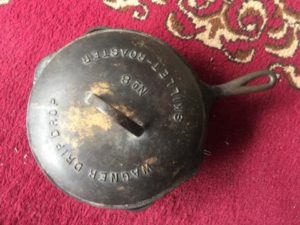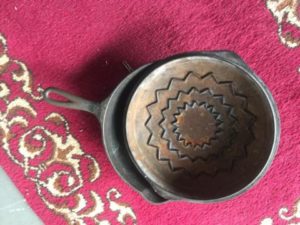 A good market exists for this rugged cookware from the late 19 and early 20th century, especially for the Griswold, Sidney, and Wagner Ware brands.
A good market exists for this rugged cookware from the late 19 and early 20th century, especially for the Griswold, Sidney, and Wagner Ware brands.
JE sent me a cast iron roaster pan and cover with “Wagner Drip Drop Skillet Roaster #8” emblazoned in raised lettering across the cover. Chefs love to cook with these heavyweights because they value cookware made of cast iron for heat retention, durability, and high heat capacity. I see a resurgence of interest in these hard-to-lift pots. This may be why my grandmother, under 5 feet tall, became extraordinarily strong for her size. JE’s pot takes both hands to manipulate. Some of the 12 inch or bigger circumference pots, when filled with boiling water or fat, are a formidable lift.
The Kitchen Stove
Europeans and Americans used cast iron for cooking before the mid-19th century, when the invention of the kitchen stove came about. In the history of humans eating, the kitchen stove is a VERY late invention. Previously we cooked food in a hearth fire, using Dutch ovens, and suspended or long handled pots. Many had feet or even legs to raise them above the cinders. Some hearths had built in chains for suspension of pots. Cooks used flat bottom cast iron pots when the kitchen range became popular in the late 19th century. By the way, JE, the size of your ring on your range matters to these pots. A ring too small for the pot may damage it, plus a small ring used for a large pot leads to inadequate heat absorption.
 Teflon and aluminum pots pushed most of the cast iron companies out of business in the 1960’s. But some cooks held onto their grandmother’s cast iron, especially those made in the late 19th and early 20th century. Chef Nigella Lawson, among other, made them “hot” again. Not to mention that since the lock-down, most of us took up slower forms of cooking! Some cooks prefer old cast iron to the more modern version of cast iron cooking. The enamel-coated cast iron pots can chip, causing less than good overall heat absorption.
Teflon and aluminum pots pushed most of the cast iron companies out of business in the 1960’s. But some cooks held onto their grandmother’s cast iron, especially those made in the late 19th and early 20th century. Chef Nigella Lawson, among other, made them “hot” again. Not to mention that since the lock-down, most of us took up slower forms of cooking! Some cooks prefer old cast iron to the more modern version of cast iron cooking. The enamel-coated cast iron pots can chip, causing less than good overall heat absorption.
These pots are cast ‘as a whole,’ handle and all, so you can used them to sear as well as bake, storing heat for much longer than any other material.
JE resuscitated this Wagner Ware Skillet Roaster from her storage locker, unopened for 12 years. The ridges in the top of the lid make it the ‘Drip-Drop.’ The roast inside ‘self-basts’ as condensation mounts. Yet she must re-season the pot. Then, no soap, no dishwasher, after re-seasoning. She must apply, using heat, multiple layers of fat. Once done, she must wash the skillet with only hot water and a brush, OR rub the pot with coarse sea salt applied with a crushed-up brown paper bag.
Collectors picky about dating Wagner Ware cast iron pots
Founded in 1891, in Sidney, Ohio, the family-owned Wagner Company led the market for years, was purchased in 1952, and still produces today. Griswold manufacturing, purchased by Wagner in 1957, branded pots Wagner after that. Not only did Wagner make cast iron cooking utensils, they hired industrial designers of the second quarter of the 20th century, and made fabulous deco-designed cast aluminum covered pans. I own one large enough for a medium sized fowl. The pot resembles The Grey Goose.
Griswold, the other top brand in cast iron, bears a distinctive cross-shaped brand mark. Founded in 1865 in Erie, PA, the factory became famous for its secretary, Ella Moses, who handled her customers’ letters for 50 years. She gave advise on products as well as recipes, finally coming out with her own cookbook, given with purchase. She became the face of the Griswold brand in the 1920-30’s.
The cross-mark brand
A larger cross means an earlier pot (1915), a smaller mark means a much later pot (1940-1957). If you don’t see ‘Erie PA,’ the pot is made after 1957-1965, at which point the brand Griswold left the market.
Joanna Pruess is a well know historian of Griswold and Wagner cooking pots, also a chef. Check out her Griswold and Wagner Cast Iron Cookbook.
JE’s Wagner Ware pot in great condition can command up to $500 today.